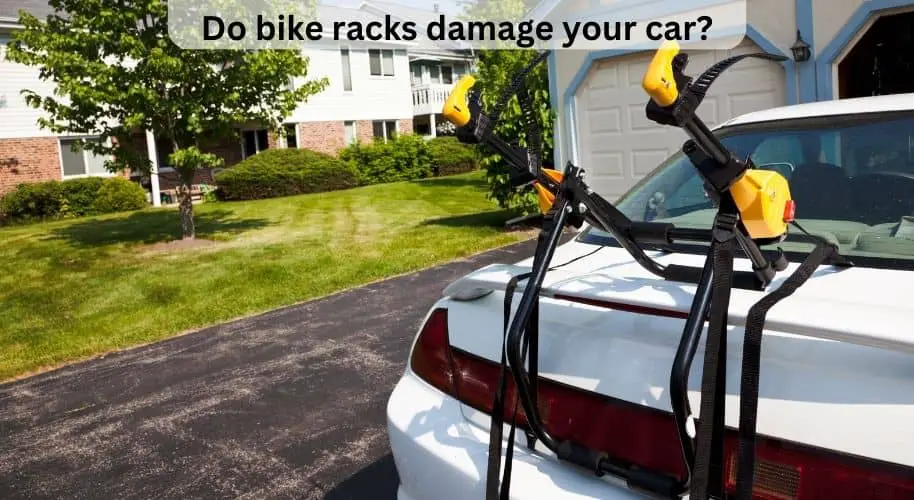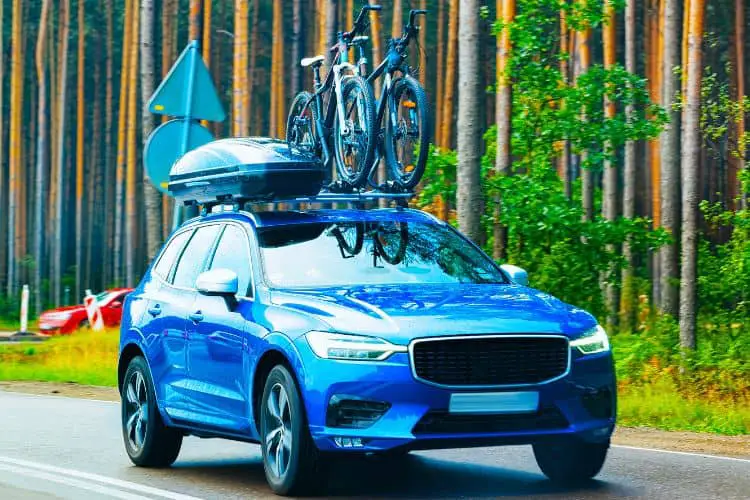Last Updated on March 14, 2023 by Henry T. Hawkins
Bike racks won’t harm the exterior of your car if you use them correctly. However, it can leave scratches and dents if you don’t install it properly or keep it on for a long time.
You must ensure that it is tightly fastened and that there is padding between the rack and your car for protection.
However, hitch-mounted or roof-mounted racks are less likely to cause damage than trunk-mounted racks, as they don’t require metal clips that could scratch the paint.
In this article, we’ll discuss some tips to help you protect your car when using a bike rack and minimize the potential for damage. Let’s continue reading!

Do bike racks damage your car?
Earlier, we said while bike racks are generally safe when used correctly, they can cause scratches and dents if not installed properly.
Trunk-mounted bike racks are the most commonly used type of bike rack and they can cause damage to a car’s paint if not installed correctly or if the metal clips that secure it to the trunk are too tight.
However, you can avoid using a rack specifically designed for your vehicle, and don’t tighten the straps too much.
Hitch-mounted and roof-mounted bike racks are also popular options, but they require more effort to install and remove than trunk-mounted ones.
We suggest checking your bike rack regularly for signs of wear and tear and ensuring it is securely attached before each use.
If you’re using a hitch-mounted or roof-mounted rack, be aware that wind resistance or wind noise while driving can be an issue.
“Make sure your car is suitable with the bike rack you intend to use. You should also take into account wind resistance, as a heavy or poorly installed rack will increase drag and reduce fuel efficiency,” says Dr. Lucian Gheorghe, an automobile engineer.
Also read: Can I add new power steering fluid to old
Are bike racks secure?

Bike racks are designed to be safe and secure for your bikes. Many bike racks come with locks, straps, or other security features to ensure your bike is securely attached to the rack.
You can also use a U-lock or chain lock to secure your bike frame and wheels to the bike rack for additional security. This will help prevent your bike theft while on the rack.
“Since not all bike racks provide the same level of safety and security, it is important to choose the proper one for your car. You should look at the features and specifications before finalizing your purchase,” added Lucian
Dr Lucian Gheorghe underlined that although bike racks are made to be secure, it is always wise to take extra security measures to protect your bike. Use a locking mechanism or other security features, and make sure you inspect the rack before each use. This will help ensure your bikes are always secure while on the rack.
Can you open trunk with bike rack?
It is not recommended to open the trunk of a car while a bike rack is attached. Doing so could cause damage to the trunk of the car, as well as to the bike rack and any bikes that are mounted on it.
The best way to access your trunk when you have a bike rack installed is to find one that can fold down or tilt away from the vehicle. This will allow you to open the trunk without having to remove the bike rack first.
If you need frequent access to your trunk, consider getting a hitch-mounted bike rack instead. These types of racks can be folded down, giving you easy access to open your trunk without risking any damage.
In any case, ensure your bike rack is mounted according to the manufacturer’s instructions to ensure its safety and effectiveness.
Also read: Symptoms of a bad steering stabilizer
Is it illegal to drive with a bike rack in the US?
In the US, using a bike rack while driving is acceptable if it is fitted and fastened correctly.
“When installing a bike rack, you should follow the manufacturer’s instructions and check local laws for any restrictions,” added Lucian. “Additionally, you should make sure that your bike is securely attached to the rack before driving.”
A bicycle rack may be used in a certain way only in specific states, which is another important thing to keep in mind. Be sure to look up the specific laws for your state, as some locations may require you to use a certain type of bike rack or only allow racks with certain types of mounting hardware.
Drivers must also make sure their license plate and rear lights are still visible when the bike rack is mounted.
How fast can you drive with a bike rack?
Although there are no restrictions on how fast you can drive with a bike rack, it is advisable to limit your speed to no more than 55 mph when using a trunk rack, 65 mph when you’re using a hitch rack, plus 80 mph if you’re using a rooftop rack. Going above this speed can cause serious risks and may result in loss of control of your vehicle.
Additionally, tests and balance measurements have shown that you should not exceed 120 km/h (74 mph) when driving with a loaded bike rack.
Then again, when driving on the highway, it is best to be extra cautious, particularly when going through curves or changes in elevation.
Also, do not forget to check your bike rack and its attachment points regularly to ensure that they are properly secured and functioning correctly. This can help ensure a safer journey for everyone involved.
For increased safety, it’s recommended to drive more slowly than usual if you have a bike rack attached to your hitch or in your trunk.
Also read: Can you reuse a spare tire
Do bike racks affect gas mileage?
Bike racks can have a significant impact on your car’s gas mileage. According to Consumer Reports conducted by Lucian, “fuel economy took a significant hit with a loaded bike rack, with up to a 28% decrease in fuel efficiency.”
Roof-mounted bike racks can decrease fuel mileage by up to 35%, and even when there aren’t any bikes mounted to them, the car’s aerodynamics and weight are still negatively affected.
Even when only one bike is on the rack, it can still cause a 9% increase in fuel use. The best way to maximize your car’s gas mileage is to remove the bike rack altogether, as this can result in a 15 mpg or 35 percent drop compared to the bike-free vehicle.
Furthermore, the type of bike rack can also affect your car’s fuel efficiency. For instance, hitch-mounted bike racks are more aerodynamic than roof-mounted ones and do not cause as much drag on the car.
Many modern hitch-mounted racks also offer better gas mileage because they come with a locking mechanism that secures the bikes in place and reduces the amount of wind resistance.
So, if you are looking to get the best gas mileage out of your car, it is recommended to remove the bike rack entirely when not in use and opt for a more aerodynamic type of bike rack when transporting bikes. With these tips, you can make sure you are always getting the most out of your car’s fuel efficiency.
Do you have to tell insurance about bike rack?
Yes! You should inform your insurance company if you use a bike rack on your car.
Ensure your insurance policy covers any potential damage the bike rack may cause. Additionally, the best action is to confirm with your insurance that the bike rack is acceptable under their terms.
Otherwise, you may not be covered in the event of an accident or collision. Some insurance companies may even offer discounts for having a bike rack installed on your vehicle, so be sure to ask about this as well.
Taking these steps can help protect you and your bike rack in the event of any unforeseen accidents.
Also read: Can you polish a wrapped car
Wrapping Up
Thanks for reading this guide on bike racks and their potential to damage your car. If you use your bike rack correctly, you can help reduce the risk of car damage.
Be sure to check the straps regularly, use a rack specifically designed for your vehicle, and don’t overtighten them.
Please share this article with your friends and family if you found it useful!
Sources:
- https://racksanytime.com/drive-fast-bike-rack/
- https://measuringstuff.com/how-fast-can-you-drive-with-bikes-on-the-roof/
- https://vehq.com/drive-with-a-bike-rack-safely/
- https://www.consumerreports.org/fuel-economy-efficiency/how-bike-racks-affect-car-fuel-economy/

